|
9595A Planar
The highest performance
microchannel planar. There are none higher.

95A Ports
95A Ports

COM ports are 345K capable
EP is an ExpressPrint parallel
port
LPT is a standard parallel port |
95A Operator Panel

|
95A Compatible Complexes
Sorry, folks, but personal experience (supported with that of
others, BTW) proves that running any other complex but a Type
4 (N, P, Q, or Y) WILL result in a 172 error code. And that's all you
will get. The planar is fine. It just won't work. Replace the complex with
a Type 4 and it will come up fine...
JMP 6 Remote Maintenence Processor
If you do NOT have a ServerGuard
adapter installed, this header MUST have a jumper on the two pins on the
right. Otherwise your system will NOT power up. Also look at JMP6.
and also the power stuff.
Hacking an 8595 Case
Yes, you CAN put a 95A planar into a 95 case. Basically,
you have to extend the port opening downward until it's 9 1/16" long. The
metal frame port opening must be extended downward so it's 9 1/16" long.
First, pull the complex, adapters, power supply, drives,
and planar. Then remove the rear bezel by removing the 5 hex head screws.
The rear bezel will pivot upwards like the front bezel. Now you can hacksaw
the frame opening downwards. I used a coping saw to cut across the bottom
of the opening.
Do the same to the rear bezel. Take a file and smooth
up the cut edges (or you WILL pay for it later!). The metal frame has a
very thin web left next to the opening for the power supply. It bent on
me when I tried to bend up a lip for the longer EMC spring on the planar.
Just say the hell with it and cut both sides of the port opening straight
down.
The real difficult part is to put the rear bezel back
on. It SEEMS easy enough. You start by putting the "hinges" on the top
of the pivots at the back of the case. Now try the delicate ballet of exactly
lining the rear bezel up with the lips on the metal frame It took me a
good 20 minutes. Note the bottom of the expansion slots has a lip that
the rear bezel MUST fit onto.
I now believe that cutting the frame while the rear bezel is
still screwed on will be the easiest way. I would still clean the fresh
edges up with a file. Use compressed air to blow any metal fragments out.
Put in the new planar. Match up the spring clip with the
lip on the frame. Push forward and pivot the planar downward onto the lip.
Make sure the screw holes match up- the planar can be too far up or down
on the lip. To adjust the height, pull the planar up and to the rear. When
it comes loose, move it the correct direction then reseat it.
Y2K Level 1 Compliant
After arduous testing in the Fortress of Solitude, I have
determined THE requirement for Level 1 compliance, and that is the Dallas
DS1585S Serialized RTC. This chip has the required routine to accept the
rollover all by itself. Other MBs that use the older Dallas DS1285 are
Level 2 compliant. (all 90s, all M class 95s, possibly X class 85s).
IEEE1284 Parallel Port
LPT A (bottom parallel port) is IEEE1284 compliant. It
is capable of transfer rates up to 2MB/S. It is also called Expressprint.
There was a prototype multiplexor for it called the F/MUX.
Parallel Port B (top parallel port) is a standard PS/2 bidirectional port.
Serial Ports
Both DB9 serial ports are capable of 345K/S.
Synchrostream Capable
This planar supports SynchroStream (for whatever good
that does). The design lets both the 32 bit data bus and the 32 bit address
bus be used for sequential data streaming after the initial data address
is sent. Go to Data Transfers for more info.
I haven't seen any suggestion that any particular OS fully uses SynchroStream,
not even OS/2.
LogicLock
This interesting bit of security
hardware is a mechanical switch that detects if someone has attempted
to open the case without using the key to unlock it. First, you need to
set the administrator's password. NOTE:
If you forget the administrator's password, you will have a planar that
will not work. There has been some attempts to replace the DS1285, but
that's not the complete fix. A VPD error keeps occuring. It seems the password
is stored in two locations?
Next you need to set the unathorized access monitor to
"Enabled" under Set Configuration. NOTE:
I do not advise you to set the unauthorized
access monitor to anything BUT disabled.
I'm still trying to understand WHAT the LL will do after
someone attempts to pry open your 95A system. It will definately log the
attempt. But what does it do after?
Wake on Ring
This planar supports Wake-On-Ring,
either from an external modem, or internal. The system will power up after
detecting a ring on Serial 1 or on a modem.
Wake On Time
You can set the time and day you want this machine to
power up. See Quick 'n Dirty Setup
9595 Main
Page
|

